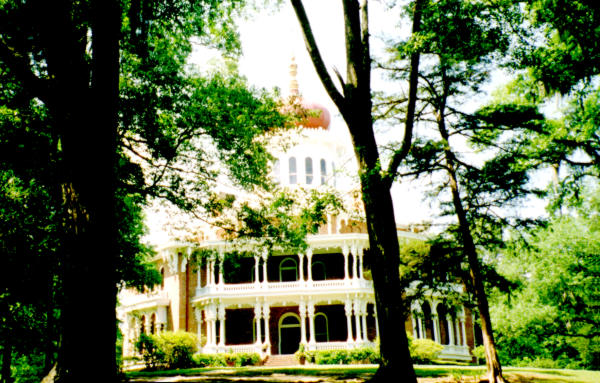In the Mississippi city of Natchez, deep among forest trees dripping with Spanish moss, stands an unfinished "Oriental Villa" known as Longwood. Planned in 1859 for cotton-nabob Dr. Haller Nutt by Philadelphia's fashionable architect, Samuel Sloan, this eight-sided castle was begun in 1860. Work halted abruptly in 1861, when the Confederate bugles echoed across the South. The Pennsylvanian artisans, busy on the Arabian palace, heeded Mr. Lincoln's call-to-arms and immediately dropped saws and hammers, heading North to pick up rifles and bayonets, never to return.
The house is unusual, with its octagonal design and sixteen-sided cupola topped with a Byzantine onion-shaped dome; yet its novelty and luxury reflected the wealth, prestige and creativeness of the affluent Dr. Nutt. The unique Muslim plan had captured the Natchezian's imagination and he proudly predicted that "after this the Octagon shape will be the style!"
Of the home's envisioned thirty-two rooms only nine on the ground floor were completed. One traveler to Natchez, writing in 1863, stated that "the house itself is rather like a pagoda, but it is beautifully furnished." The twentieth, century traveler will agree.
On the walls are the architect Sloan's drawings of the mansion as it was to have been, a six-story structure of brick, plaster and marble with eight rooms on each floor centered around a rotunda. Indirect lighting was to be provided by large mirrors in the dome reflecting sunbeams to smaller mirrors to light the gloomy interior below. Orders to France, England and Italy had been sent for elaborate furnishings, mosaic floors, marble mantels, statues and stairways, and splendid tapestries. Many of these costly pieces were enroute on the high seas and were seized by the Federal blockade. Today some of these are in national museums.
When the war that suddenly burst upon the nation deprived him of his workmen and subsequently his wealth, Dr. Nutt dejectedly settled his family into the lower floor. Although a Union-sympathizer, the doctor, nevertheless, saw a million dollars' worth of rich cotton land burned or confiscated by Union soldiers. A broken man, he died of pneumonia in 1864 leaving, still incomplete, his Longwood, "the remembrancer of Eastern magnificence which looms up against the mellowed azure of a Southern sky."
Nutt's descendants occupied the basement rooms for the next one hundred Years. In 1970, the house was presented to the Pilgrimage Garden Club which is lovingly maintaining it. Now a National Historic Landmark, it is open daily to the public, its eight-sided elegance marking art end to an era and standing as a ghostly monument to the heart-rending break of the Way Between the States.
See Winter Quarters to learn more about Dr. Nutt and the way of life on a cotton plantation.
